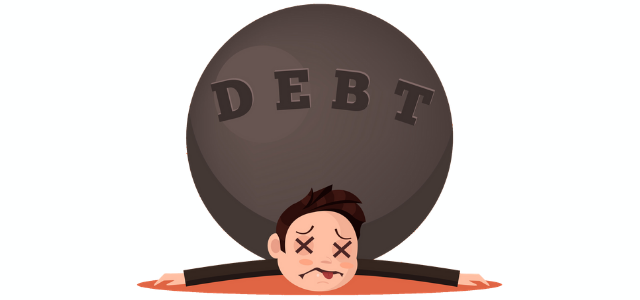Sri Lanka’s debt pile has ballooned to US$ 100.18 billion, amid marginal improvement in some macroeconomic barometers, while unpaid principal and interest on selected debt exceed US$ 6.4 billion.
More than US$ 12 billion of International Sovereign Bond (ISB) debt remains unpaid; a US$ 500 million ISB is due for payment later this month, and Sri Lanka now owes US$ 10.5 billion to the Asian Development Bank (US$ 6.2 billion) and the World Bank (US$ 4.3 billion).
The Finance, Economic Stabilisation, and National Policy Ministry’s first quarter public debt data, released under IMF requirements, show domestic debt has surged to US$ 57.28 billion from US$ 52.64 billion at the end of December—a nearly 9% increase.
Since Sri Lanka suspended servicing the external debt of bilateral and commercial creditors in April 2022, unpaid debt service has piled up to US$ 4.45 billion, while unpaid interest has ballooned to US$ 2.08 billion by the end of last year, separate data from the Government show.
In the quarter ended December 2023, Sri Lanka’s debt was US$ 96.17 billion. That was a year after the unprecedented economic collapse propelled by monetary and fiscal recklessness and policy missteps.
The ADB and the World Bank have repeatedly provided macroeconomic first aid and financed various critical projects, especially in the past few years. They account for more than 90% of the multilateral debt, the data show. It was the World Bank that financed cooking gas shipments with a US$ 70 million loan to Litro Gas when the country was reeling and also provided US$ 500 million in budget support, including for ‘Aswesuma’ cash support in December.
The World Bank trained the Finance Ministry staff to mitigate interest rate risks (potential net present value savings on future interest payments of about US$ 38 million) and financial risk and liquidity management.
The IMF is owed US$ 672.3 million.
Central government debt as a percent of economic output was at 103.9% in 2023, separate data show.
Sri Lanka is in debt to several European and Asian governments and several international banks such as HSBC (UK) and HSBC (Hong Kong), The Riggs National Bank (Washington DC), ING Bank and Rabobank (Co-op Centrale Raiffeisen) of the Netherlands, Austria’s Raiffesen Zentral Bank, and Standard Chartered Bank (UK).
Debt to China Development Bank is US$ 2.18 billion (term financing facilities) of which the unpaid principal is US$ 463.3 million.
Japan is owed US$ 2.35 billion. The unpaid principal is US$ 291.2 million. South Korea is owed US$ 294.6 million. The unpaid principal is US$ 26.9 million.
On March 14, a US$ 1 billion, five-year International Sovereign Bond with a coupon of 6.85% became due. It was not paid due to the debt service suspension. On April 18, a US$ 1.25 billion, 10-year ISB with a coupon of 6.75% became due, but it was not paid either.
On June 28, a US$ 500 million, five-year ISB with a coupon of 6.35% falls due.
Of the external debt, 71% is US dollar-denominated, while 6% is Japanese yen.
The outstanding domestic debt was US$ 12.92 billion in the first three months, compared with US$ 12.63 billion in the final quarter of 2023.
Last year, the government got US$ 2.12 billion in foreign financing by signing 16 agreements with foreign development partners and lending agencies. Of this, US$ 2.02 billion was loans.
The overhaul of domestic debt (Treasury bond exchange with superannuation funds and Treasury bill exchange with the Central Bank of Sri Lanka) needed to restore debt sustainability, was completed in September 2023, and by the end of November 2023, it was agreed to restructure billions owed to official creditors. Haggling with external commercial creditors is continuing without much visibility. A round of talks ended in March in London.
A recent World Bank assessment flagged that “downside risks remain high’’. The WB has recommended that “a sufficiently deep debt restructuring is needed to restore Sri Lanka’s debt sustainability.’’
The government’s gross financing needs (the sum of amortisation, interest payments, and the primary balance) have been high due to a large Treasury-bill rollover at high domestic interest rates.
The IMF’s second health check is expected to be completed this month.
Separate data show that domestic interest payments eat up Rs 2.45 trillion, and they have increased by 56.9%. Subsidies, such as pensions (Rs 372.4 billion), cost less than half that amount.
The government’s expenditure remains high, and spending has blown out by 19.8% to Rs 5.35 trillion in 2023 from Rs 4.47 trillion.
Outstanding foreign debt as a percentage of gross domestic product was 42.1% in 2023.
External debt service payments were US$ 2.58 billion in 2023 compared with US$2.48 billion in 2022. In 2023, external debt service payments were lower following a suspension of selected government debt since April 2022.
In 2023, the economy contracted by 2.3% last year after shrinking by 7.3% in 2022.
